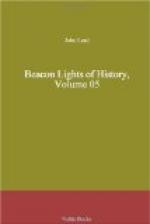It now remains to us to contemplate Anselm as a theologian and philosopher,—a more interesting view, for in this aspect his character is more genial, and his influence more extended and permanent. He is one of the first who revived theological studies in Europe. He did not teach in the universities as a scholastic doctor, but he was one who prepared the way for universities by the stimulus he gave to philosophy. It was in his abbey of Bec that he laid the foundation of a new school of theological inquiry. In original genius he was surpassed by no scholastic in the Middle Ages, although both Abelard and Thomas Aquinas enjoyed a greater fame. It was for his learning and sanctity that he was canonized,—and singularly enough by Alexander VI., the worst pope who ever reigned. Still more singular is it that the last of his successors, as abbot of Bec, was the diplomatist Talleyrand,—one of the most worldly and secular of all the ecclesiastical dignitaries of an infidel age.
The theology of the Middle Ages, of which Anselm was one of the greatest expounders, certainly the most profound, was that which was systematized by Saint Augustine from the writings of Paul. Augustine was the oracle of the Latin Church until the Council of Trent, and nominally his authority has never been repudiated by the Catholic Church. But he was no more the father of the Catholic theology than he was of the Protestant, as taught by John Calvin: these two great theologians were in harmony in all essential doctrines as completely as were Augustine and Anselm, or Augustine and Thomas Aquinas. The doctrines of theology, as formulated by Augustine, were subjects of contemplation and study in all the convents of the Middle Ages. In spite of the prevailing ignorance, it was impossible that inquiring men, “secluded in gloomy monasteries, should find food for their minds in the dreary and monotonous duties to which monks were doomed,—a life devoted to alternate manual labor and mechanical religious services.” There would be some of them who would speculate on the lofty subjects which were the constant themes of their meditations. Bishops were absorbed in their practical duties as executive rulers. Village priests were too ignorant to do much beyond looking after the wants of hinds and peasants. The only scholarly men were the monks. And although the number of these was small, they have the honor of creating the first intellectual movement since the fall of the Roman Empire. They alone combined leisure with brain-work. These intellectual and




